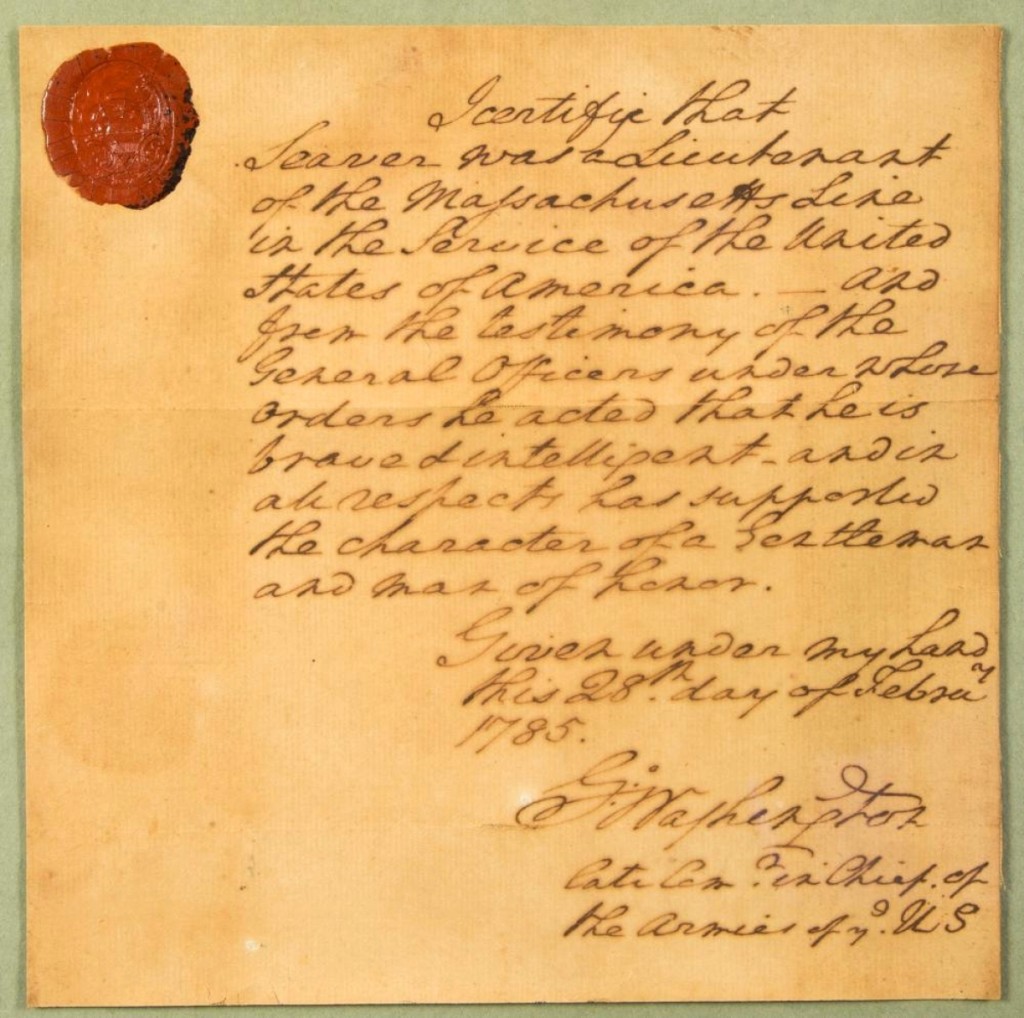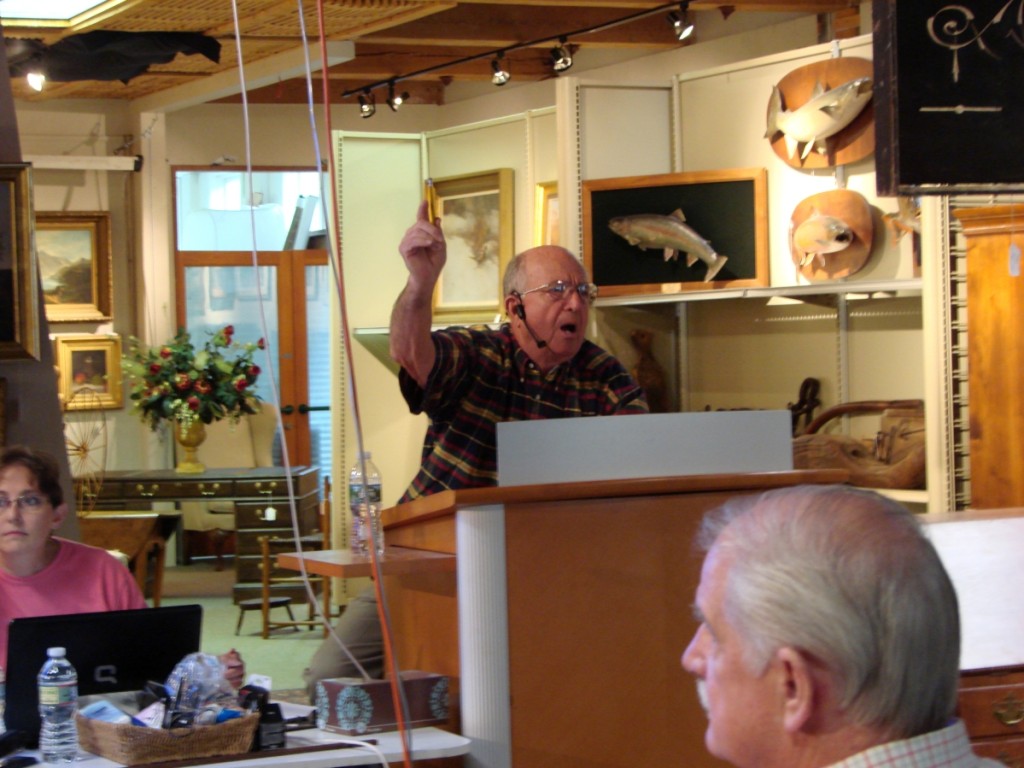
Expected to be the highlight of the sale was a letter written and signed by George Washington, attesting to the character of an officer in the Revolutionary War. Washington signed it “late Commander in Chief of the US Armies” and it realized $21,600.
Review and Onsite Photos by Rick Russack
PETERBOROUGH, N.H. – The Cobbs Auctioneers’ July 14 sale was topped by an important George Washington letter that sold for $21,600, a collection of trade signs and country store items, White Mountain paintings and early firearms. Charlie Cobb’s sales get a good-sized crowd in this day of internet bidding; several phone lines were in use, and there were numerous absentee bids. Much of the material came from two New Hampshire collections, both of which included numerous items with connections to the region and state. It is probably a safe guess that much of what was sold will reappear during the upcoming New Hampshire Antiques Week shows.
You might be surprised to learn that an Amazon company is providing a service that could be useful to auctioneers, museums and historical societies. For anyone wishing to buy an illustrated, full-color catalog for this sale, Cobb’s website directs the customer to an Amazon website. When asked, Charlie Cobb and staffer Nick Prior explained that an Amazon company, CreateSpace, provides print-on-demand copies of their catalogs. This is the second time Cobb has printed his catalogs this way. The photographs and layout are done by Prior, who Cobb gives all credit to, and uploaded to CreateSpace. As a customer places an order for the catalog, a copy is printed and mailed. If the buyer is an Amazon Prime member, there is no charge for the mailing. Cobb and Prior both said that the service also enables bidders who won an item at auction, and who then may decide they would like a hardcopy catalog for their records after all, to purchase one online after the sale.
Expected to lead the sale, and succeeding in doing so, was a letter written and signed by George Washington in 1785. It was a complimentary reference for an officer who had served during the Revolution “in the service of the United States of America.” Estimated at $9,000, it sold for $21,600. Washington’s signature included “late Commander in Chief of the US Armies” and it bore Washington’s red wax seal. Also selling for more than expected was an unsigned painting similar to the iconic “Washington at Dorchester Heights” by Gilbert Stuart. Estimated at $700, it sold for $3,210. A letter written by General John Stark, with good Revolutionary War content, earned $1,920. In it, Stark is writing to Colonel Marinus Willett, later mayor of New York City, telling him that he had ordered troops to join Willett’s forces at Fort Rensselaer. Each of these items, along with about 100 other lots came from the Peterborough estate of Steve Millard.
The sale began with 175 lots from the collections of Bob and Jan Weeks. Bob Weeks had been in the advertising business in New York City and began collecting advertising items and assorted farm equipment and accessories after moving to New Hampshire. Many of the signs were from the area and many sold well over their estimates. A large Masonite sign for “Robart Farm Registered Herefords” depicted a well-groomed Hereford steer in a grassy field. It was signed BFS Saunders, Hartford, and was thought to have been done in the Twentieth Century. It sold for $5,400. Also doing well and selling for $4,200 was a gilded tin sign in the form of a pair of eyeglasses, with a red lens on one side and a blue lens on the other. An exceptional wooden sign with an arched top advertising “N.P. Skinner Tinner and Roofing” earned $3,480. The sign had some paint loss and sold to a dealer in the room. Of local interest was a gold-lettered sign for the Monadnock National Bank. The bank, which had been located in East Jaffrey, N.H., opened in 1865 and printed its own money until 1935. The sign had been exhibited several times locally and sold for $2,400 to a member of the family that had owned the bank. Also of local interest was a mid-Nineteenth Century leather fire bucket lettered “Ashuelot Bank Fire Bucket NO. 1,” which sold for $2,400. This bank was in nearby Keene from 1833 to 1934, and eventually had a total of three branches. The Weeks collection also included numerous country store wooden and tin advertising boxes, which sold in lots of three to six items.
Cobb’s sales often include White Mountain paintings, and this sale was no exception, with works by Benjamin Champney (1817-1909), Samuel Lancaster Gerry (1813-1891), Harrison Bird Brown (1831-1915) and others. Most popular with buyers was Gerry’s scene of Mount Washington and Tuckerman Ravine, with the short Ellis River in the foreground and some long-gone houses. It went to a phone bidder for $9,600. Brown’s landscape of a rugged mountain scene also went to a phone bidder for $7,200. Another of Brown’s oils, this one of a White Mountains stream crossed by a footbridge, went to an internet bidder for $2,640. Champney’s unidentified White Mountain scene with mountains and a river sold for $3,950. A painting of Mount Washington, signed AT Bricher sold for $6,000 in spite of a catalog notation that said the signature was “not his usual form.”
This is the time to buy good American furniture, it just does not bring what it once did. An outstanding Eighteenth Century two-door cupboard in early blue with exceptional hand-forged hardware brought only $3,600. It had been in the Kellogg collection, with Florene Maine provenance, which Northeast sold for $12,980 in 2011. A New Hampshire Queen Anne maple highboy with fan carving and an old refinished surface went for $12,000. A Dunlap school candlestand struggled to get to $840, but a reproduction Donald Dunlap tiger maple slant front desk earned $2,760. A Sheraton elliptical front flip top card table, circa 1815, on spiral turned tapered legs went for $84. A serpentine mahogany Chippendale drop leaf Pembroke table, probably made in Massachusetts, brought $180.
There was a small selection of firearms, including a rare circa 1818 Henry Deringer percussion Indian Trade rifle which sold for $6,600, more than twice its estimate. Although Deringer is best known for his small pocket pistols, early in his gun manufacturing career he often built military arms and Native American trade pieces for the US government. In 1809, he received his first contract with the US Office of Indian Trade for trade rifles. He soon became the primary supplier of rifles to the Indian Trade Office for the government-owned trading posts. The original government contract called for Deringer to produce 2,000 .54 caliber flintlock rifles in 1814. The catalog description of this gun’s condition is quite detailed and ends by saying, it is “unmodified with original uncleaned surfaces.” Also exceeding its estimate was a British short land “Brown Bess” flintlock infantry musket, with correct triangular bayonet, manufactured at Dublin Castle. Guns like these were used by the British army during the American Revolution. The gun shows some skillful repairs, possibly done during its time of service. It brought $5,400 from a buyer in the room.
A few days after the sale, Charlie Cobb said that it had been a good day. “We had a good crowd and some things did really well. I’ve spoken to our consignors and they’re quite pleased with the way it went. The trade signs were strong, with many going well over our estimates. Decoys were good and the White Mountain paintings did well for us, bringing what they should have. Cataloging of the early firearms was done by Sarge Collier of Mason, N.H., who is well-known to firearms collectors. His catalog descriptions were excellent and helped us get the prices that we did. We’re getting calls on some of the stuff that didn’t sell, so I think everyone did well, both consignors and buyers.”
All prices include the buyer’s premium as reported by the auction house. For more information, www.thecobbs.com or 603-924-6361.






























